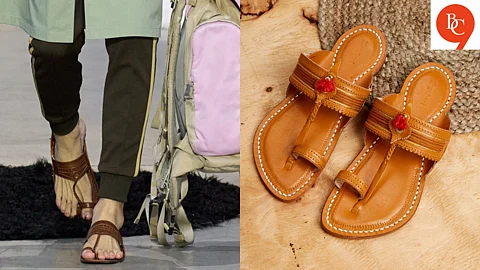

Kolhapuri chappal, a traditional Indian leather slipper known for its earthy resilience and ethnic charm. Priced at over ₹50,000, this high-fashion reinterpretation of an indigenous Indian design sparked not just surprise but outrage, particularly among Indian designers, social commentators, and craftspeople.
Yet what happened in the aftermath of this controversy has largely remained under the radar.
A Quick Primer: What Is a Kolhapuri Chappal?
The Kolhapuri chappal is a handcrafted, open-toed leather sandal originating from Kolhapur and surrounding districts in Maharashtra. Traditionally made from vegetable-tanned buffalo hide, the chappal is built to last decades, often passed down as heirlooms. The designs range from simple single-strap styles to intricate multi-strap versions with toe loops, woven panels, and tassels.
Unlike factory-made footwear, Kolhapuris are stitched without nails, and the process of tanning and finishing relies on natural dyes, neem bark, myrobalan, and lime, making the craft environmentally sustainable long before it became trendy.
In 2019, following a long battle for recognition, Kolhapuri chappals received the Geographical Indication (GI) tag, covering eight districts across Maharashtra and Karnataka. This certification ensures authenticity and prevents misuse of the name by non-local producers.
The Prada Moment: When Global Fashion Blinked
In mid-2018, Prada released images from its Spring/Summer 2019 menswear collection. Among the many items featured on the runway was a tan leather sandal with a thick toe strap, a top flap, and detailed perforation—eerily reminiscent of the Kolhapuri chappal. The product was simply listed as “leather sandals,” and there was no mention of India, Kolhapur, or the craft’s heritage.
The model sold for ₹56,000 (approximately €650).
Social media, especially Indian Twitter and fashion circles, lit up with criticism. Designers like Wendell Rodricks, academics, and even casual observers questioned the lack of acknowledgment, with some accusing Prada of “cultural appropriation with a price tag.”
However, no legal action was taken by the Indian government or artisan collectives. Unlike cases involving patented designs or copyrighted artwork, India’s traditional crafts exist in a legal grey area when it comes to international imitation—especially when a brand doesn’t explicitly name the source.
The Silence That Followed: No Credit, No Collaboration
Prada never officially commented on the controversy. And that silence was telling.
There was no attempt at collaboration, no credit given to Indian artisans, and no engagement with the growing call for fair-trade sourcing in heritage crafts. It wasn’t just about intellectual property—it was about ethical responsibility and visibility.
What made the situation even more disappointing was the missed opportunity. Several artisan clusters in Kolhapur and Athani had hoped the global spotlight would lead to international partnerships, trade inquiries, or at the very least, increased demand. None of that happened.
Why the Controversy Matters—Even Today
The Prada-Kolhapuri controversy is not just an old story from 2018. It represents an ongoing problem in the global fashion economy:
1. Unequal Power Dynamics in Design
Designers from developing nations often see their traditional crafts replicated without credit, while Western brands profit from the aesthetic under the banner of “reinvention” or “fusion.”
2. No Financial Benefits to Original Makers
Despite the viral moment, the Prada incident did not result in increased income or exposure for Kolhapuri artisans. The average Kolhapuri chappal still sells for ₹500–₹2,000, with most artisans earning less than ₹10,000 a month.
3. Risk of Dilution
Once a luxury brand mimics an indigenous craft without proper attribution, the market floods with counterfeit or fusion versions—watering down the significance and value of the original item.
The Kolhapuri chappal isn’t merely a sandal—it’s an emblem of India's living craft heritage. The Prada incident should have sparked a movement toward fair collaboration, design ethics, and global recognition for local talent. Instead, it left a question mark hanging over the fashion world’s approach to traditional crafts.
